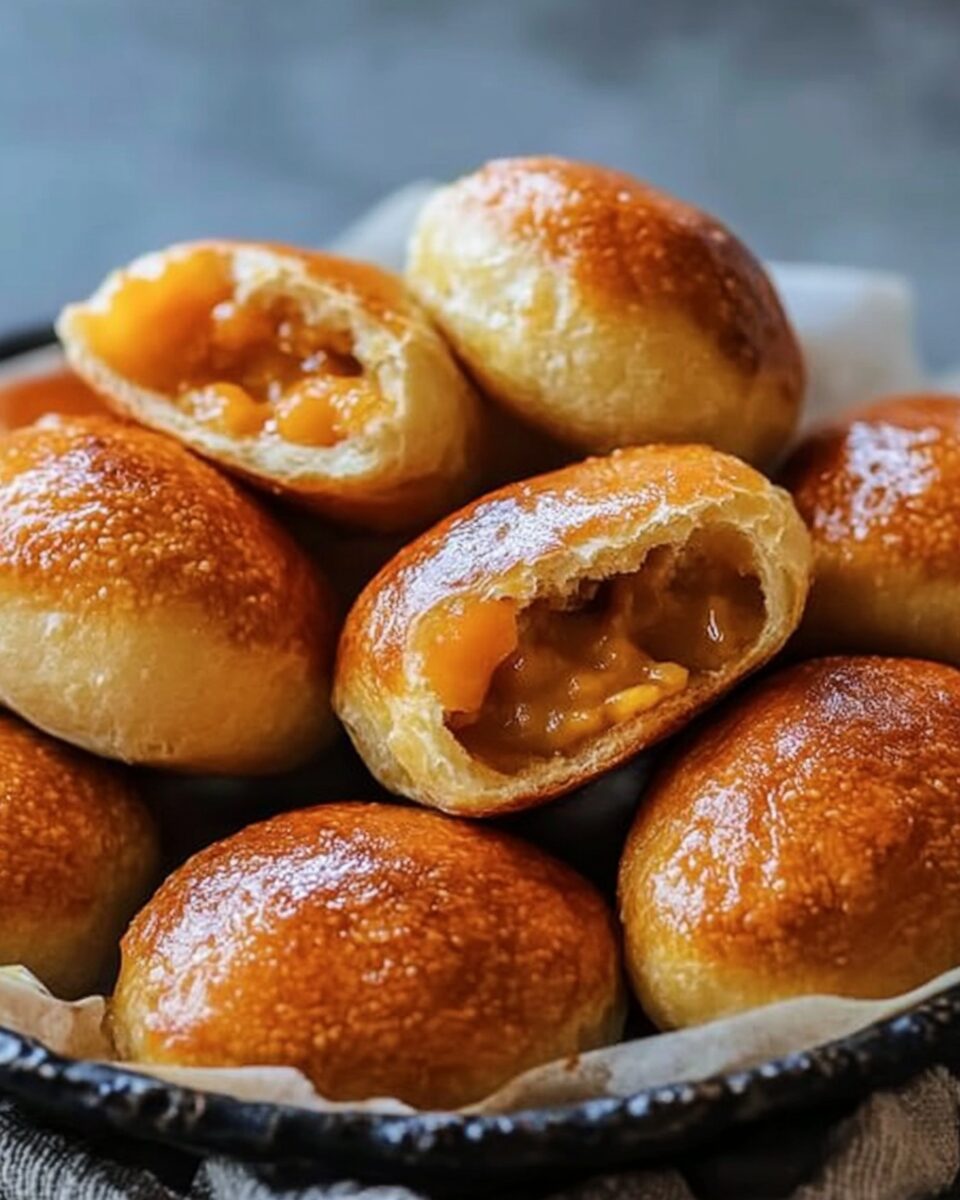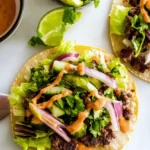Vegan Japanese Curry Bread Buns, also known as Kare Pan, are a delightful fusion of soft bread filled with a savory curry filling, coated in breadcrumbs, and baked to golden perfection. This recipe offers a plant-based twist on the traditional Japanese favorite, making it suitable for vegans and those seeking a delicious appetizer or snack.
FULL RECIPE:
Ingredients:
- For the Dough:
- 1 cup (240 ml) warm plant-based milk (e.g., soy or almond)
- 2 tablespoons sugar
- 2 teaspoons active dry yeast
- 3 cups (375 g) all-purpose flour
- 1 teaspoon salt
- 2 tablespoons vegan butter, softened
2. For the Curry Filling:
- 1 tablespoon vegetable oil
- 1 small onion, finely chopped
- 2 cloves garlic, minced
- 1 medium potato, diced
- 1 medium carrot, diced
- 1/2 cup frozen peas
- 2 tablespoons curry powder
- 1 tablespoon all-purpose flour
- 1 cup (240 ml) vegetable broth
- Salt and pepper, to taste
3. For Coating:
- 1/2 cup (120 ml) plant-based milk
- 1 cup (120 g) panko breadcrumbs
Directions:
- Prepare the Dough: In a bowl, combine warm plant-based milk and sugar. Stir until sugar dissolves. Sprinkle active dry yeast over the mixture and let it sit for 5-10 minutes until frothy. In a large mixing bowl, whisk together all-purpose flour and salt. Add the yeast mixture and softened vegan butter. Mix until a dough forms. Knead the dough on a lightly floured surface for about 8-10 minutes until smooth and elastic. Place the dough in a lightly oiled bowl, cover with a damp cloth, and let it rise in a warm place for 1 hour or until doubled in size.
- Prepare the Curry Filling: Heat vegetable oil in a pan over medium heat. Sauté chopped onion and minced garlic until translucent. Add diced potato and carrot to the pan. Cook for 5-7 minutes until slightly tender. Stir in curry powder and all-purpose flour, coating the vegetables evenly. Cook for another 2 minutes. Pour in vegetable broth, stirring continuously to prevent lumps. Bring the mixture to a simmer and cook until the vegetables are tender, and the sauce thickens. Season with salt and pepper to taste. Let the filling cool completely.
- Assemble the Buns: Punch down the risen dough and divide it into 8 equal portions. Shape each portion into a ball and flatten it into a disc. Place a spoonful of the cooled curry filling in the center of each disc. Gather the edges and pinch them together to seal the filling inside. Shape each filled dough into a ball and place seam-side down on a baking tray lined with parchment paper.
- Coat the Buns: Preheat the oven to 350°F (175°C). Brush each bun with plant-based milk and roll them in panko breadcrumbs, ensuring an even coating. Arrange the coated buns on the baking tray, leaving space between them. Cover with a damp cloth and let them rest for 15 minutes.
- Bake the Buns: Bake in the preheated oven for 20-25 minutes or until golden brown. Remove from the oven and let them cool slightly before serving.
Nutrition Facts
- Calories: 250 kcal
- Carbohydrates: 40 g
- Protein: 6 g
- Fat: 7 g
- Saturated Fat: 1 g
- Trans Fat: 0 g
- Cholesterol: 0 mg
- Sodium: 300 mg
- Fiber: 3 g
- Sugar: 3 g
The History and Origin of Japanese Curry Bread (Kare Pan)
Japanese Curry Bread, or Kare Pan (カレーパン), is a beloved snack in Japan, often found in bakeries, convenience stores, and supermarkets. This delightful dish combines the influences of Japanese curry, which was introduced to Japan in the late 19th century, and Western-style bread, which became popular during the Meiji period. The idea of encasing a rich and flavorful curry filling in a soft dough, coating it in breadcrumbs, and deep-frying or baking it to crispy perfection resulted in Kare Pan a truly unique fusion of flavors and textures.
Why Choose a Vegan Version?
As plant-based diets gain popularity worldwide, people are looking for ways to enjoy classic comfort foods while sticking to their dietary preferences. This Vegan Japanese Curry Bread recipe offers a cruelty-free alternative to the original, replacing ingredients like beef or pork with hearty vegetables and plant-based seasonings. The result is a flavorful and satisfying dish that does not compromise on taste or texture. A vegan version of Kare Pan not only caters to those following a plant-based lifestyle but also introduces a healthier alternative by eliminating animal fats and cholesterol. Additionally, it allows for more creative interpretations, with ingredients such as lentils, mushrooms, or tofu serving as excellent substitutes for traditional meat-based fillings.
Baking vs. Frying: Which Method is Better?
Traditional Kare Pan is deep-fried, which gives it a crisp, golden exterior. However, frying significantly increases the calorie and fat content. Despite these differences, the baked version of Kare Pan still maintains a crispy crust, thanks to the coating of panko breadcrumbs, which mimic the crunchiness of the fried version.
Serving Suggestions and Pairings
Vegan Japanese Curry Bread Buns can be enjoyed in various ways:
- As a snack or appetizer: These buns are perfect for on-the-go eating, making them ideal for picnics, lunchboxes, or quick snacks.
- With a side of salad or soup: Pairing these buns with a light salad or a bowl of miso soup creates a well-balanced meal.
- With a dipping sauce: Although they are flavorful on their own, you can serve them with a light soy-based dipping sauce or a vegan mayo-based dip for extra taste.
Storage and Reheating Tips
To ensure that your Kare Pan stays fresh and crispy, follow these storage and reheating tips:
- Refrigeration: Store leftovers in an airtight container in the fridge for up to 3 days.
- Freezing: You can freeze the baked buns for up to 1 month. To reheat, let them thaw at room temperature before warming them in the oven.
- Reheating: To maintain the crispy texture, reheat in a preheated oven at 350°F (175°C) for 5-10 minutes. Avoid microwaving, as this can make the bread soggy.
Health Benefits of Vegan Curry Bread
This plant-based version of Kare Pan offers several health benefits:
- Lower in cholesterol and saturated fats – Since it contains no dairy or meat, it’s heart-friendly.
- Rich in fiber – The vegetables and whole ingredients contribute to better digestion.
- Nutrient-dense – With ingredients like carrots, potatoes, and peas, it provides vitamins and minerals.
Cultural Significance and Popularity in Japan
Kare Pan is a staple in Japanese bakeries and can be found in almost every konbini (convenience store). It is often enjoyed as a quick snack, alongside coffee or tea. Some specialty bakeries even offer seasonal variations, using ingredients like pumpkin in the fall or incorporating regional flavors for local twists. The popularity of Kare Pan has also spread beyond Japan, with many bakeries in the U.S., Europe, and other Asian countries offering their own versions. The appeal lies in its crispy exterior, warm filling, and satisfying bite, making it a comfort food loved by many.
Conclusion
Vegan Japanese Curry Bread Buns (Kare Pan) are a delicious, plant-based twist on a beloved Japanese classic. Whether you bake or fry them, these buns deliver a satisfying combination of crispy bread and rich, savory curry. By choosing a vegan version, you not only make a healthier and more ethical choice but also get to enjoy the dish with customizable fillings and flavors. Perfect as a snack, appetizer, or even a light meal, Kare Pan is an excellent dish to make at home, share with friends, and introduce others to the delicious world of Japanese fusion cuisine.






